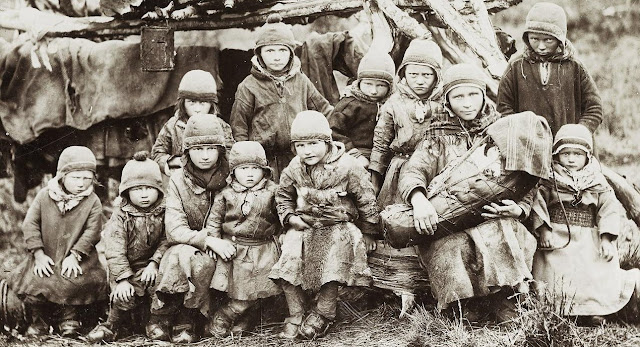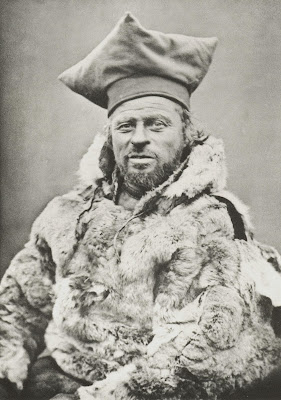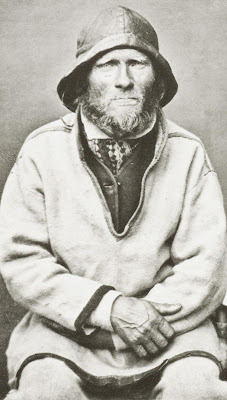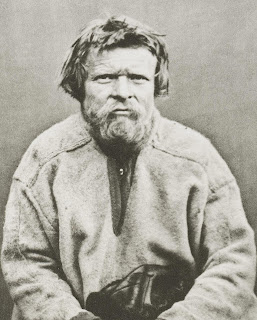 Drawing: Johannes Scheffer Acta Lapponica, VIII . First edition published in 1673 in Frankfurt.
Drawing: Johannes Scheffer Acta Lapponica, VIII . First edition published in 1673 in Frankfurt.Skiers are found in old rock carvings in the Nordic areas, for instance one in Alta, Norway from about 3200 years ago. However some rock carvings are older, like the ones hyperlinked under.
Skiløpere er funnet i gamle helleristninger i de Nordiske landene, for eksempel 3200 år gamle fra Alta, Norge. Noen helleristninger er imidlertid eldre, se i følgende hyperlenker.
Petroglyph Close up of 3 skiers
Petroglyphs Heritage in Karelia
In year 98 AD Tacitus called a north-western people "Phinnoi" or “Fenni” according J. B. Rives (translation of "Germania" by Tacitus, 1999). The term "phinnoi" is believed to derive from a German word “fintha” = “to find” and there is a parallel with this term and “wanderers” and “gatherers”.
The Old Greek Ptolemy (after 83 – 161 AD) refers to “phinnoi of Skandia”.
A Palestinian born philosopher Procopius (about 500 - 565 AD) described a Scandinavian tribe as “Scrithiphinoi” meaning “Finns on skis”. That description fits the nomadic lifestyle descriptions of the Saami back in history.
Jordanes from the 6th century AD made a more profound description of the “Screrefennae” (see W.D. Frank) and according to Rives (1999) his text makes it more certain that that the “scritofini” are the same as the Saami.
Ravenna (700eds AD) referred to Scirdifini, Sirdfeni, Serdifenni and Rerefeni (L. I. Hansen & B. Olsen, 2004).
Paulus Diaconus, or Warnefridi (720 - 800 AD) wrote that the Scritobini (e.g. the Saami) chased animals that were not very unlike stags (this very likely refers to the reindeer) and overtake the wild beasts with a piece of wood that is bent and looks like a bow. In lack of a word to describe "gliding on skis" he used the word "leaping" (German).
King Alfred the Great (849 - 899) and Adam of Bremen (about 1075) used terms Skride-Finnas and Scritefini and in later edtions of their works other forms such as Scritefini, Scricessimi, Scritesfinni and Scritefinni are used.
Skis are drawn on an Sámi drum found in Historia Norwegiae from about 1190. Even if Historia Norwegia is criticised for not describing Saami shaman practises correctly, the drum shows some of the important symbols for the Saami people.


Outstanding and sophisticated decorations on a northern Saami ski from 1894. Utrolig vakkert og kunstferdig dekorert nordsamisk ski fra 1894. Source: "Ur skidans och snöskons historia" by Göran Rosander, Västerbotten Årbok, 1964.
I året 98 etter Kristus kalte Tacitus et folk i nordvest for “Phinnoi” eller “Fenni” i følge J. B. Rives (oversettelse av ”Germania” av Tacitus, 1999). Termen ”phinnoi” antas å komme fra det tyske ordet ”fintha” som betyr ”å finne” og det er en parallell med denne termen og ”vandrere” og ”samlere”.
Den gamle grekeren Ptolemy (etter 83 - 161 e.Kr.) referer til ”phinnoi av Skandia”.
En Palestinskfødt filosof med navnet Procopius (omtrent 500 – 565 e. Kr.) beskrev en Skandinavisk folkestamme som ”Scrithiphinoi”, som betyr ”Finner på ski”. Den beskrivelsen passer den nomadiske måten å leve på som samene hadde tilbake i historien.
Jordanes fra det 6 århundre etter Kristus gjorde en bedre beskrivelse av ”Screrefennae” (se artikkelen til W.D. Frank) og i følge Rives (1999) så er man ut fra denne teksten sikrere på at “scritofini” omhandler samene.
Ravenna (700-årene etter Kristus) brukte termer som Scirdifini, Sirdfeni, Serdifenni and Rerefeni (L. I. Hansen & B. Olsen, 2004).
Paulus Diaconus, eller Warnefridi (720 – 800 e. Kr.) skrev at Scritobini (dvs. samene) jagde dyr som ikke var så ulik kronhjorten (dette var svært sannsynlig reinsdyr) og at de overvinner de ville dyrene med en stykke tre som er bøyd og ser ut som en bue. I mangel på ord for å beskrive ”å gli eller skli på ski” brukte han ordet som beskriver ”å hoppe” (tysk).
Kong Alfred den store (849 – 899) og Adam av Bremen (ca. 1075) brukte termer som Skride-Finnas og Scritefini og i senere utgaver av skriftene sine brukte de ord som Scritefini, Scricessimi, Scritesfinni og Scritefinni.
Ski er tegnet på en samisk tromme funnet i Historia Norwegiae omtrent i år 1090 e. Kr. Selv om Historia Norwegiæ er kritisert for å ikke beskrive samisk sjaman-praksis korrekt så viser trommen symboler som var viktig for samene. Saami ski tip from Ajaur and Klöverfors in Västerbotten parish. Samisk skitupp fra Ajaur og Klöverfors i Västerbottens län. Source: Västerbotten Årbok, 1964.
Saami ski tip from Ajaur and Klöverfors in Västerbotten parish. Samisk skitupp fra Ajaur og Klöverfors i Västerbottens län. Source: Västerbotten Årbok, 1964.
Grettis Saga (1200 - 1300) in Grágás Konungsbók and Norwegian Gulathing law tells about the skiing Saami among the normal things in life also in Southern Norway: “Here, among other things it is said that an enemy shall have peace as long as the falcon flies, the pine grows, rivers flow to the sea, children cry for their mother and the Saamis go skiing.” End of quote from Else Mundal
The Gulating law is from before 900 AD until 1274/1276 and the law were in force for most of Western Norway.
Grettis saga (1200 -1300 tallet) i Grágás Konungsbók og den norske Gulatingsloven forteller om de skigående samene som en del av den normale verden også i Sør-Norge: "Desse eidane lova fred til ein fiende. Her er det mellom anna sagt at fienden skal ha fred “så langt som falken flyg, furua gror, elvar flyt til havet, barn ropar på mor og finnar [dvs. samar] går på ski." Sitat slutt fra: ”Kva fortel dei norrøne skriftlege kjeldene om historia til sørsamane” av Else Mundal
Gulatingsloven er en lov som er fra før 900 AD og gjaldt for store deler av vestlandet helt til 1274/1276.
Olaus Magnus (1555) used the term "Scrisfinnia" in "History of the Northern Peoples". Olaus Magnus (1555) brukte termen "Scrisfinnia" i det historiske verket om de nordlige folk.
 Saami skiers from Historia by Olaus Magnus in 1555. Samiske skiløpere from “Historia de gentibus septentrionibus” av Olaus Magnus i 1555.
Saami skiers from Historia by Olaus Magnus in 1555. Samiske skiløpere from “Historia de gentibus septentrionibus” av Olaus Magnus i 1555.
Meriot (1984) tells about how Olaus Magnus mixed his own observations with the prejudices of his time about the Saami. He wrote “Historia de gentibus septentrionibus” after visiting the Saami in 1515. You can see some of his engravings in the added segments from the remarkable map Carta Marina, 1539. It is worth the time to take a closer look at it.
“Skis and ski-poles (planis lignis and baculum) are fully described, as are the reindeer skins that were fixed on the skis to prevent heir slipping back when going uphill. … the right ski- called savek except when it was covered with skin (golos) - was shorter than the left ski, which was stronger and had a grooved inner surface to support the weight of the skier (Magnus, 1555:1,4). The ski-pole was very long and had a pointed tip like that of the bear spears (Fig. 2). Magnus also traced in his work the geographical spread of the Scricfinni and Lappones who were, in fact, one and the same.” (End of quote from the article by Christian Meriot, 1984).
 Skiing Godess SKADE: A Saami woman after Olaus Magnus, 1539. En samisk ski gudinne called SKADE tegnet i “Historia de gentibus septentrionibus” by Olaus Magnus, 1555.
Skiing Godess SKADE: A Saami woman after Olaus Magnus, 1539. En samisk ski gudinne called SKADE tegnet i “Historia de gentibus septentrionibus” by Olaus Magnus, 1555.
Meriot (1984) forteller leseren at Olaus Magnus blandet sine egne observasjoner med datidens fordommer om samene. Han skrev verket “Historia de gentibus septentrionibus” etter å ha besøkt samene i 1515. Du kan se noen av hans graveringer i denne bloggen og to segmenter fra det utrolig flotte kartet Carta Marina, 1539. Det er vel verdt å bruke tid til se nærmere på hele kartet.
Fritt oversatt fra artikkelen til Meriot (1984): ”Ski og skistaver (planis lignis og baculum) er grundig beskrevet, likeså reinsdyrskinn som ble satt på skiene for å forhindre at de glir bakover når man går i oppoverbakker. … den høyre skien – kalles savek bortsett fra når den er dekket med skinn (golos) – var kortere enn den venstre skien, som igjen var sterkere og hadde et spor på den innerste overflaten for å støtte vekten av skiløperen( Magnus, 1555: 1,4). Ski-staven var svært lang og hadde en tagg på spissen slik som et bjørnespyd (fig. 2). Magnus sporet også opp den geografiske spredningen av Scricfinni og samene (Lappones) som faktisk var en og samme folk.” (Sitat slutt fra artikkelen av Christian Meriot, 1984).
 Saami Skiers including a long haired skiing woman in Finnmark from Carta Marina by Olaus Magnus in 1539. Samiske skiløpere inkludert en langhåret kvinne på ski i Finnmark fra Carta Marina av Olaus Magnus i 1539. Carta Marina, 1539
Saami Skiers including a long haired skiing woman in Finnmark from Carta Marina by Olaus Magnus in 1539. Samiske skiløpere inkludert en langhåret kvinne på ski i Finnmark fra Carta Marina av Olaus Magnus i 1539. Carta Marina, 1539
 Sami men on skis and riding reindeers while defending themselves using clubs, bow and arrows against men with horses and spears. Samiske menn på ski eller ridende på reinsdyr mens de forsvarte seg med klubber, pil og bue mot menn med hest og spyd. Source: Carta Marina by Olaus Magnus, 1539. Carta Marina, 1539
Sami men on skis and riding reindeers while defending themselves using clubs, bow and arrows against men with horses and spears. Samiske menn på ski eller ridende på reinsdyr mens de forsvarte seg med klubber, pil og bue mot menn med hest og spyd. Source: Carta Marina by Olaus Magnus, 1539. Carta Marina, 1539
”Finnas” (Swedish etymology dictionary).
"Finnas" mean "sking". It is incorrect that Skrithiphinoi (Procopius) or “Finnas” i.e. the Saami only come from Northern Sweden as stated in this dictionary. The Saami still today live in Jämtland and as late as 1880ies it was reported that Älvdal, Dalarna in Southern Sweden mainly had a population of Saami origin (Paul B. Du Chaillu, 1882). There is a photo in this blog of ski poles from Orsa finnmark in Dalarne. I will return to this subject in a later blog. There are texts and archaeological finds that supports that the Saami from early on lived far south in Scandinavia. In some texts from the southern Nordic areas the skiing Saami have been mentioned, as you saw in the quote from Mundal’s article.
”Finnas” (svensk etymologisk ordbok).
”Finnas” betyr skigåing. Det er ikke korrekt at Skrithiphinoi (Procopius) eller "Finnas" = samene kun er fra Nord Sverige slik det hevdes i denne ordboken. Samene bor fremdeles i dag i Jämtland og så sent som i 1880-årene ble det rapportert at Älvdal i Dalarne i det sørlige Sverige i hovedsak hadde en befolkning som var av samisk opprinnelse (Paul B. Du Chaillu, 1882). Det er et foto i denne bloggen av skistaver fra Orsa finnmark i Dalarne. Jeg skal komme tilbake til dette tema i en senere blog. Det finnes tekster og arkeologiske funn som viser at samene fra tidlig av holdt til helt sør i Skandinavia. I noen tekster fra Sør-Skandinavia er også de skigående samene nevnt, som du så i sitatet fra artikkelen til Mundal.
Fridtjof Nansen writes according to this web site: “Lapps are called ‘Finns,’ both in Old Norse and modern Norwegian...”
It is well known that the Saami people have been called "fenni" and "finns" for as long as history is written in the Nordic. The old terms “fenni”, "finn" and “finns” should not be confused with the population of present Finland ( e.g. Answers “Fenni”). Of course many people in present Finland are of Saami origin, but there have been massive immigrations to Finland particularly within historical time. Some of these migrating people (particularly agriculturists from Russia) mixed with the Saami and some of their descendants identify with the Saami while others do not. Today many people have lost their Saami cultural connections even if they genetically are connected with the Saami.
Fridtjof Nansen skriver i følge denne Internett siden (fritt oversatt): ”Samene er kalt for ”Finner” både på gammelnorsk og på moderne norsk…”
Det er velkjent at samene er kalt ”fenni” og ”Finner” så lenge det har vært skrevet historie i Norden. De gamle termene “fenni”, “finn” og “finner” må ikke forvirres med befolkingen i dagens Finland (e.g. Answers “Fenni”). Det er helt sikkert at mange i dagens finske befolkning har samisk opprinnelse, men det har vært massive immigrasjoner til Finland spesielt innen historisk tid. Noen av folkene som kom med disse migrasjonene (spesielt jordbrukere fra Russland) blandet seg med samene og noen av deres etterkommere identifiserer seg med samene mens andre ikke gjør det. Mange har i dag tapt forbindelsen med den samiske kulturen selv om de genetisk er forbundet med samene.
 Saami ski poles: One with elk horn and the other one (1882) with inscription is from Orsa finnmark in Dalarne, Sweden. Samiske skistaver: En med elghorns håndtak og en fra 1882 med gravering som er fra Orsa finnmark i Dalarne, Sverige. Nordisk Museum. Source: "Ur skidans och snöskons historia" by Göran Rosander, Västerbotten Årbok, 1964.
Saami ski poles: One with elk horn and the other one (1882) with inscription is from Orsa finnmark in Dalarne, Sweden. Samiske skistaver: En med elghorns håndtak og en fra 1882 med gravering som er fra Orsa finnmark i Dalarne, Sverige. Nordisk Museum. Source: "Ur skidans och snöskons historia" by Göran Rosander, Västerbotten Årbok, 1964.
A Saami ski from the southern part of Lappland made about 1870. Source: "Ur skidans och snöskons historia" by Göran Rosander, Västerbotten Årbok, 1964 
A Saami ski from Norrbotten made by Lars Henrik Thurfjell in 1866. Source: "Ur skidans och snöskons historia" by Göran Rosander, Västerbotten Årbok, 1964
Fur-coated ski. Skinnskodd skida from Museiverket, Helsingfors. The fur-coat makes the skier silent and prevents the skier from sliding backwards when going uphill.
Old drawing Saami hunting and Skiing by Chatelain
Pulk, piggstav, seletøy og ski ved et stabbur. Abraure 1948, Arjeplog (Sverige)
 Scanned photogravure published in 1930 (Atlantis-Verlag, Berlin). Jokkmokk Laplanders looking after their reindeers. Jokkmokk samer ser etter sin reinsdyrflokk.
Scanned photogravure published in 1930 (Atlantis-Verlag, Berlin). Jokkmokk Laplanders looking after their reindeers. Jokkmokk samer ser etter sin reinsdyrflokk. Saami children putting on skis, 1930ies. Samiske barn tar på seg ski, 1930-årene. Scanned old postcard.
Saami children putting on skis, 1930ies. Samiske barn tar på seg ski, 1930-årene. Scanned old postcard. Different types of ski pole points. Ulike typer skistav spisser. Source: Västerbotten Årbok, 1964.
Different types of ski pole points. Ulike typer skistav spisser. Source: Västerbotten Årbok, 1964. Saami leather coated skis from Northern Norway: Ethnographic Museum in Copenhagen. Samiske ski trukket med lær fra Nord-Norge: Etnografisk Museum i København. Source: Västerbotten Årbok, 1964.
Saami leather coated skis from Northern Norway: Ethnographic Museum in Copenhagen. Samiske ski trukket med lær fra Nord-Norge: Etnografisk Museum i København. Source: Västerbotten Årbok, 1964. Saami women with skis. Samiske kvinner med ski. Scanned old postcard.
Saami women with skis. Samiske kvinner med ski. Scanned old postcard.
References / Referanser:
"Samenes historie frem til 1750" av Lars Ivar Hansen og Bjørnar Olsen, 2004.
"Germania: by Cornelius Tacitus". Translated with Introduction and Commentary by J. B. Rives; Clarendon Press, 1999.
"The Land of the Midnight Sun: Summer and Winter Journeys through Sweden, Norway, Lapland and Northern Finland, with Descriptions of the Inner Life of the People, Their Manners and Customs, the Primitive Antiquities..." Vol. 1 and 2 by Paul B. Du Chaillu; Harper & Brothers, 1882.
”Tacitus' "Fenni" and Ptolemy's "Phinnoi"” by Ian Whitaker. The Classical Journal, Vol. 75, No. 3 (Feb. - Mar., 1980), pp. 215-224
Samenes dunkle fortid i norske arkeologiske tekster
”The Saami Peoples from the Time of the Voyage of Ottar to Thomas von Westen” by Christian Meriot, 1984
”Coexistence of Saami and Norse culture – reflected in and interpreted by Old Norse myths” by Else Mundal
"Ur skidans och snöskons historia" by Göran Rosander, Västerbotten Årbok 1964, Umeå. Redigerad av Gunnar Westin och Ernst Westerlund.
”Greek myth and modern skiing: A historical Etymology” by W.D. Frank


























 En vill-lapp i pesk fra 1700-tallet. Kopperstikk av E.D. Clarke publ. i 1819. 1700s A Wild Laplander man in fur by E.D. Clarke publ. 1819
En vill-lapp i pesk fra 1700-tallet. Kopperstikk av E.D. Clarke publ. i 1819. 1700s A Wild Laplander man in fur by E.D. Clarke publ. 1819










